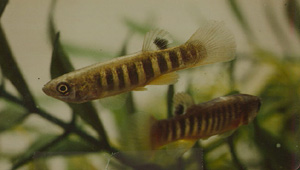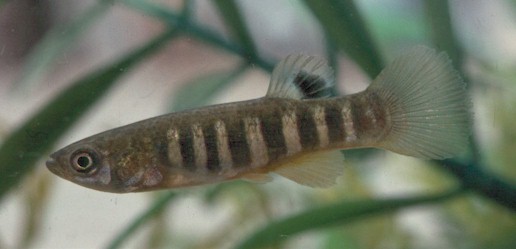Fish in Focus: Spotfin killifish, Fundulus luciae

Spotfin killifish, Fundulus luciae
© Fritz Rohde
Spotfin killifish, Fundulus luciae – Salt Marsh Survivor
Members of the killifish genus Fundulus are renowned for their survival skills in habitats most fishes find inhospitable. The spotfin killifish, Fundulus luciae, is found in salt marshes on the Atlantic coast from Georgia to Massachusetts. Spotfins thrive in an environment extreme even for a Fundulus; their preferred niche is in salt marshes among the Spartina grasses along the high tide line in waters that might average 2 or 3 cm deep. This environment is subject to large swings of temperature, oxygen, and water cover. At low tide spotfins can often be found in shallow muddy troughs, or even wrapped around the bases of clumps of Spartina. The only other fish commonly encountered in this strip between dry land and stable water is another killifish, F. heteroclitus commonly known as the mummichog.
Spotfins are small fish never larger than 5 cm. They’re named after a dorsal ocellus carried by males. Wild spotfins are so well adapted to their muddy environment that they don’t glisten out of water like most fishes, but rather have a flat gunmetal gray base color. No other fish must complete its life cycle on the salt marsh as does the spotfin; mummichogs are often found in marsh creeks or in bays, but spotfins of any age are rarely found outside their narrow strip of upper marsh. An apparent advantage of this specific niche is safety from predatory fishes unable to navigate the watery muds of the upper marsh; but the spotfin must still contend with wading birds. Adults feed on medium-sized zooplankton and emergent insects, while juveniles search out smaller zooplankters such as rotifers and nematode worms.
The best way to collect spotfins is with a fine-mesh dipnet with a stout handle. Hip waders are highly recommended for mobility around the marsh. Look for shallow (I mean shallow) pools of standing water on the surface of the uppermost marsh, and scoop out net-fulls of mud. Dump your catch on firmer ground and start picking through it. You’ll find spotfins trying to snake out and return to the marsh surface. They can adapt surprisingly easily to aquarium conditions (i.e., they don’t need stagnant water and stinking mud). They do best in salt water but can be weaned to fresh water, as long as the fresh water is hard. Several aquarists have mentioned that they do much better in captivity if not kept with mummichogs that seem to out-compete and stress the spotfins.
These fish can be surprisingly common in marshes, but live in a place obscure to most people. They’re not the flashiest fish but are respectably handsome.

Spotfin Killifish, Fundulus luciae
© Fritz Rohde
Written by Bruce Stallsmith